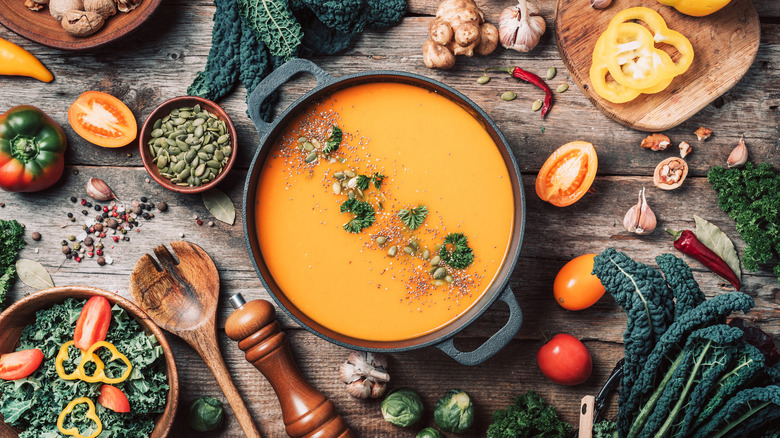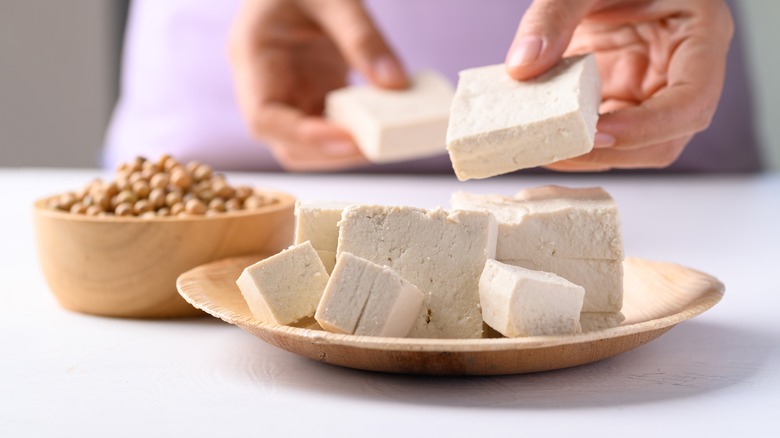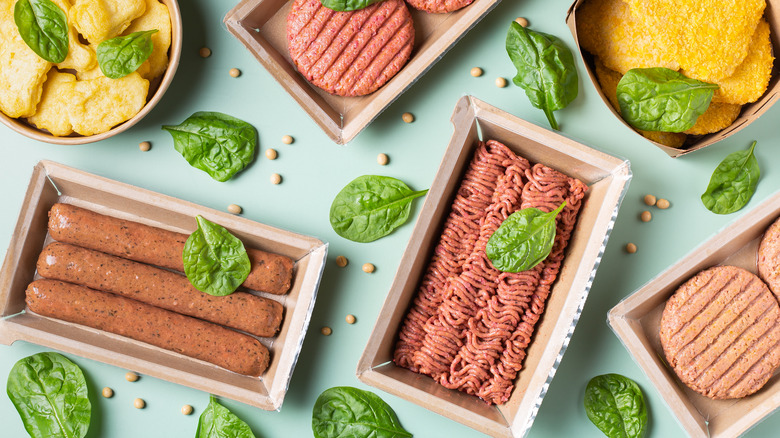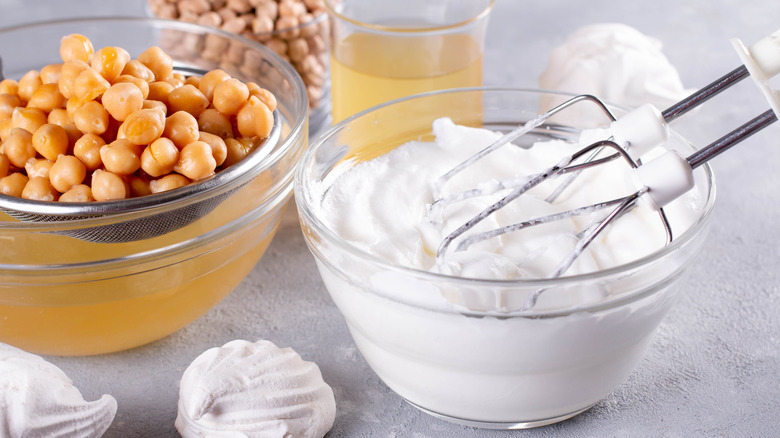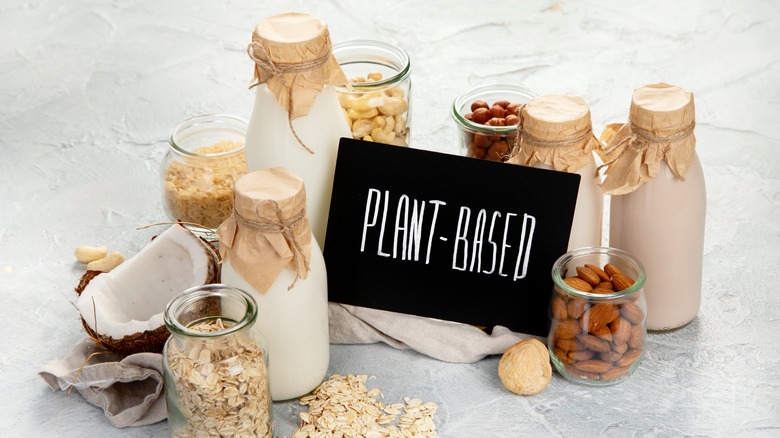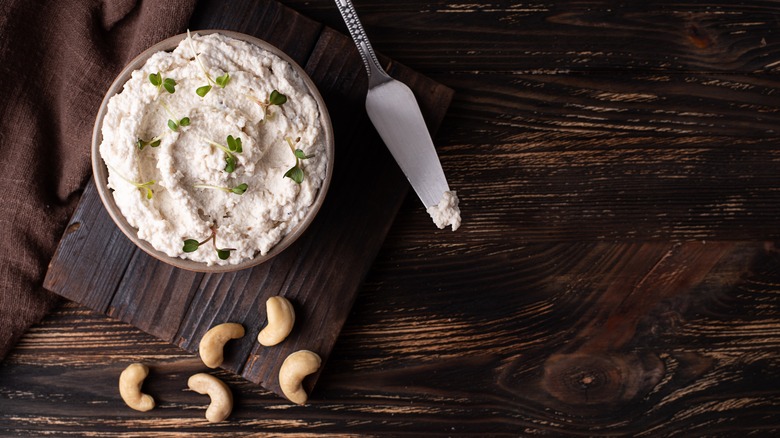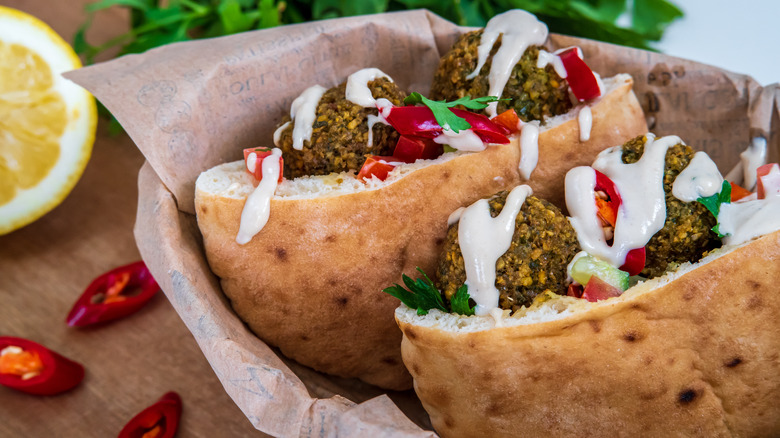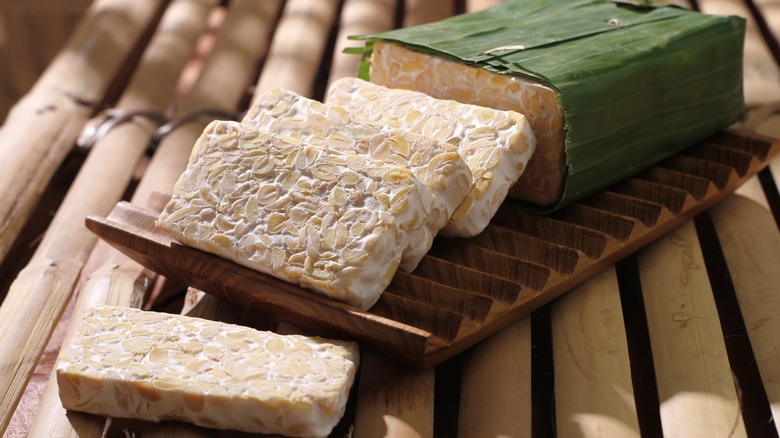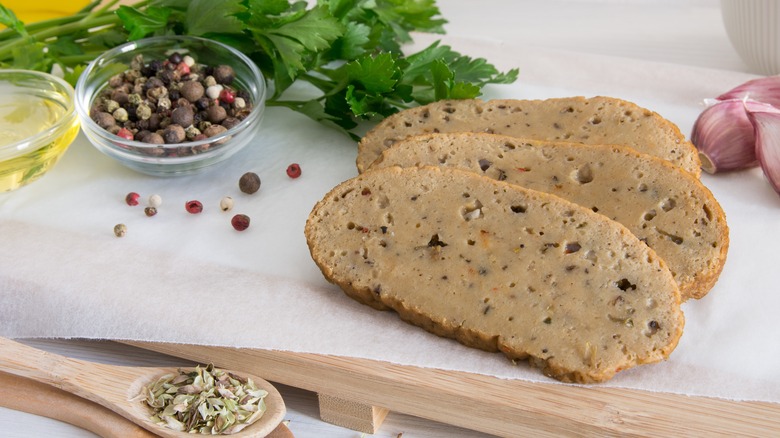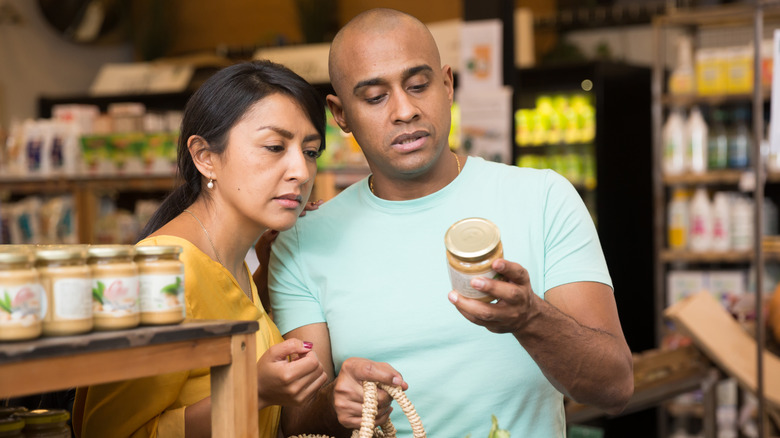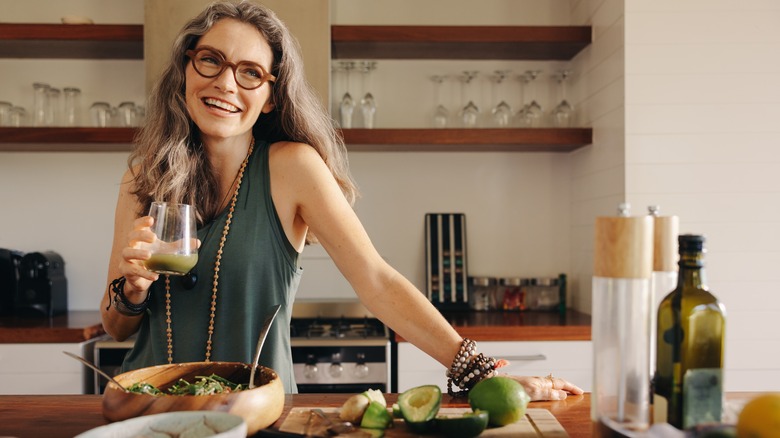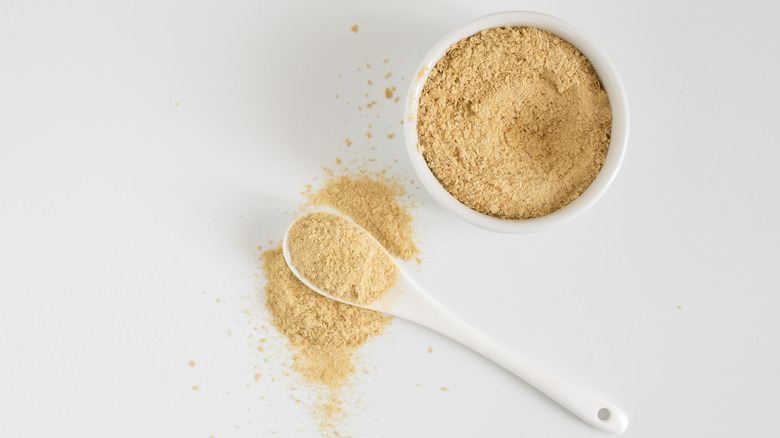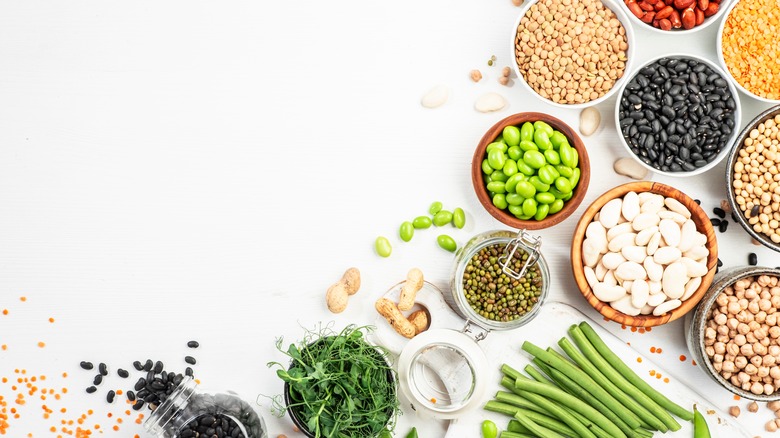Mistakes Everyone Makes When Cooking Vegan Food
There are so many reasons to embrace a vegan diet — or even just reduce your intake of animal products — but the truth is that cooking vegan food can go awry. It isn't inherently more difficult than preparing non-vegan recipes, but there us a learning curve that presents new techniques and ingredients to get your head around. Still, with the increasing demand for vegan food, novice and seasoned chefs alike are eager to explore this culinary territory.
However, venturing into the realm of vegan cooking comes with its challenges and even the most well-intentioned cooks can stumble along the way. From ingredient substitutions gone wrong to overuse of mock meats and commercial vegan cheeses, there are common mistakes that everyone seems to make when preparing vegan dishes. These mistakes can lead people to believe that cooking vegan is difficult or that vegan food just isn't as tasty as dishes that contain meat or other animal products.
Don't dismiss vegan food just yet, however. We'll uncover some common vegan cooking missteps and provide practical tips and tricks to help you master the art of vegan cooking, ensuring that your plant-based meals are as delicious as they are nutritious. So, grab your apron, sharpen those knives, and let's dive into the world of vegan cuisine, one mistake at a time!
Underseasoning tofu
Tofu, the versatile superstar of the vegan universe, has managed to win over even the most skeptical taste buds with its ability to absorb flavors and mimic various textures. However, one common mistake that many home cooks make when preparing tofu is underseasoning this product. It's no secret that tofu on its own can be bland, so getting seasoning just right is key. Imagine biting into a piece of tofu that lacks the savory punch you were expecting — disappointing, right? Underseasoned tofu is nothing short of lackluster and uninspiring.
But how does this issue happen? It could be a result of timid flavor choices, a misconception that tofu will magically absorb all the surrounding flavors, or perhaps a fear of overpowering the delicate nature of this soy-based wonder. However, the truth is that tofu craves a bold and confident hand in the seasoning department.
Marinating tofu is one way to avoid underseasoning it — such as in this punchy baked tofu recipe that takes its inspiration from Mexican cuisine. You can also toss cubes of tofu in a blend of cornstarch, salt, and seasonings of your choice before pan-frying it. This gives it an excellent crispy texture, not to mention the seasoning that it needs to taste great.
Relying too much on mock meats
Now, don't get us wrong — we adore the convenience and versatility of mock meats. They offer an array of textures and flavors that can help bridge the gap between a meat-centric diet and a plant-based lifestyle. However, like any good thing, moderation is key.
One of the primary reasons to exercise caution with mock meats is their highly processed nature. This is okay, as they're not necessarily intended to be healthy and not everything you put in your body has to be perfectly balanced. However, if you eat them for every meal, you might not end up getting all the nutrients you need.
Another pitfall of relying heavily on mock meats is the missed opportunity for culinary exploration. The vibrant world of plant-based cuisine offers a treasure trove of ingredients, flavors, and cooking techniques waiting to be discovered. By relying too much on mock meats, you risk narrowing your culinary horizons. You may end up missing out on the diverse array of fruits, vegetables, legumes, grains, and spices that can elevate your vegan dishes to new heights. Embrace the kaleidoscope of colors and textures nature has to offer, and you'll be rewarded with a feast that is not only delicious but also nutritionally balanced. So, embrace the beauty of balance. Use mock meats in moderation, allowing them to enhance dishes rather than dominate them. You can also use them to replace meat in some of your old favorite recipes.
Missing out on novel ingredients
In the flavorful realm of vegan cooking, the possibilities seem endless, and the ingredients at your disposal are as varied as the colors of a rainbow. Yet, amidst the vibrant tapestry of plant-based options, there's a grave mistake that many aspiring vegan chefs make — ignoring novel or unusual ingredients.
Vegan cooking has some weird and wonderful components and it's a big mistake to miss out on them. One such ingredient is aquafaba, the liquid drained from a can of chickpeas. This ingredient that you'd normally wash away down the sink whips up in a manner similar to egg whites. As such, you can use it to make recipes that were once off-limits in vegan cooking, such as pavlovas and silky-smooth Swiss meringue buttercreams. It's also a great egg substitute for many baked goods.
Black salt — also known as kala namak — is another novel ingredient worth exploring. This sulfuric salt is commonly used in Indian cooking, but its unique taste makes it especially useful in a range of vegan recipes. Add it to scrambled tofu or a vegan frittata to elevate its egg-like flavor.
Making too many substitutions to non-vegan recipes
If you trawl the comment section of any recipe, you'll find someone saying that they replaced chicken with tofu, butter with chia seeds, and egg with lentils — and it was awful. Well, naturally. You can't expect to replace half the ingredients in a non-vegan recipe with vegan substitutions and have it come out the same. So, at least when you're starting out with vegan cooking, don't attempt to make too many substitutions at once. Choose recipes that only require you to switch one or two ingredients. Do that, and it's more likely to be plain sailing than if you need to substitute every other ingredient.
Also, make sure you make smart, like-for-like substitutions. For instance, use vegan butter in place of dairy butter, non-dairy milk in place of cow's milk, or your favorite mock meats in place of meat. Finally, realize that some recipes just weren't meant to be veganized. For instance, there's currently no good substitute for eggs in a classic carbonara recipe. The egg substitutes that you'd use in baking, such as aquafaba or chia seeds, simply won't work there. If you attempt that type of substitution, it's going to be a disaster.
Of course, your vegan superpowers will grow stronger over time, so as you get more used to adapting non-vegan recipes, it will become more obvious when and how to substitute ingredients.
Using commercial vegan cheeses too often
Vegan food can be incredibly delicious, but we must address the looming specter of store-bought vegan cheese. The truth is, it's often bad. If you're transitioning to a vegan diet and still remember the taste of dairy-based cheese, you're going to be disappointed. Still, commercial vegan cheeses have undoubtedly come a long way. Your local market likely offers a good selection of dairy-free alternatives, from gooey mozzarella to crumbly feta, all of which strive to replicate the flavors and textures of their dairy-based counterparts. The trouble is, they often fall short.
The good news is that it's absolutely possible to make your own vegan cheese. You can make quick cheeses, such as this cashew cheese, or you can get deep into culturing your own cheese, a process that can take weeks or even months.
It's also worth mentioning that there are some excellent vegan cheeses on the market made by small producers, rather than large commercial brands. You might find these small-batch artisan vegan cheeses at farmers' markets or your local independent health food store. They're often cultured similarly to dairy and can be left to mature over long periods of time.
Not looking for inspiration from international cuisine
Imagine limiting your taste buds to the confines of familiar dishes and flavors, never venturing beyond your comfort zone. It's like traveling to another country but refusing to immerse yourself in its culture and traditions. By neglecting international cuisine, we deny ourselves the opportunity to embrace new ingredients, cooking techniques, and flavor combinations that can transform our vegan creations into mouthwatering masterpieces.
Each region of the world boasts its own culinary heritage, a tapestry woven with unique spices, herbs, and cooking methods that have been perfected over centuries. By seeking inspiration from international cuisine, we can infuse our vegan dishes with a world of flavors. Discover the umami richness of miso in Japanese cuisine, the aromatic spices of Moroccan tagines, or the vibrant citrus tang of Mexican salsas. Introduce your taste buds to the exquisite balance of sweet, sour, salty, and spicy flavors found in Thai cuisine, or savor the intricate layers of herbs and spices in Middle Eastern dishes.
Many cultures have a range of dishes that are either intentionally or accidentally vegan. For instance, there are many vegan Ethiopian dishes due to the Ethiopian Orthodox Church's fasting traditions that prohibit consuming animal products for the majority of the year. Falafel is found all over the Middle East and is almost always vegan, as are many other Middle Eastern mezze dishes, such as ful medames and warak enab.
Avoiding tempeh
We get it — tempeh might sound weird. One of the holy trinity of vegan proteins (along with tofu and seitan), it's made from soybeans that are pressed together and fermented to form a sliceable slab of slightly funky goodness. This might not sound particularly appetizing, but it's similar to how many cheeses are made.
If you're a little freaked out by tempeh, it's understandable. However, this food dates back centuries to Indonesia and people have been safely and happily eating it since then, so there's nothing to worry about. Due to its nutrient profile and great taste and texture, avoiding it is a mistake. Packed with protein, fiber, and a range of essential vitamins and minerals, tempeh provides a wholesome and satisfying foundation for any plant-based meal. It offers a complete amino acid profile, making it an ideal protein source for vegans and vegetarians.
Beyond its nutritional value, tempeh possesses a remarkable ability to absorb flavors and spices, making it a culinary chameleon that adapts to nearly any creation. Plus, tempeh's unique texture adds a delightful dimension to your dishes. Unlike its softer tofu sibling, tempeh offers a substantial bite that lends itself well to grilling, sauteing, or baking.
Not learning to make seitan
Seitan is the wheat-based wonder that has captured the hearts and taste buds of many a vegan adventurer. In the world of plant-based cooking, failing to learn the art of making seitan is a serious mistake that often goes unnoticed. Also known as wheat meat, seitan offers a hearty and satisfying alternative to animal-based proteins. Made from gluten, the protein found in wheat, seitan possesses a remarkable ability to mimic the texture and appearance of meat, making it a staple in many vegan kitchens. Yet, for some, the intricacies of seitan preparation may seem daunting, leading them to opt for store-bought alternatives.
However, learning to make seitan yields immense rewards. One of the key reasons to master the art of seitan is the unparalleled control the technique offers you over flavor, texture, and overall culinary experience. By crafting your own seitan, you can become the architect of a protein masterpiece. You have the freedom to customize the seasonings, spices, and herbs that infuse your seitan with a symphony of flavors. From smoky barbecue notes to punchy spices, the possibilities are as vast as your imagination. No longer bound by the pre-packaged limitations, you can fine-tune your seitan to suit your preferences and create a truly unique dining experience.
Trying to make every vegan meal healthy
Veganism is often touted as a healthy way of eating, but the fact is that it doesn't have to be. Like any way of eating, it can be as healthy or unhealthy as an individual makes it. While some vegans eat nothing but whole grains, fruits, vegetables, and legumes, others subsist on a diet of Oreos and frozen vegan pizzas.
For many diners, neither of these extremes is ideal. If you try to make every vegan meal healthy, you might end up sick of the sight of grain bowls and chickpea salads, craving a burger and fries. Instead, many find that a good diet is balanced, which means it's fine to sometimes make yourself an elaborate plate of vegan nachos or eat vegan corn dogs for dinner.
Many people new to vegan baking also fall for the mistake of trying to make their baked goods lower in fat or sugar. This might be why so many people think that vegan cakes and cookies are inferior to egg- and dairy-laden ones. There's a time to be mindful of your sugar intake, of course, but it's certainly not when you're enjoying occasional vegan baked goods.
Not reading labels
Whether you're new to veganism or cooking for a vegan friend or relative, you might make the common mistake of failing to read product labels and therefore accidentally using a non-vegan ingredient. Imagine whipping up an elaborate vegan meal, only to realize afterward that the stock you used contained meat or dairy.
Even when you check the label, there are some non-vegan ingredients that might not be obvious at first glance. For instance, vitamin D3 is commonly derived from sheep's wool, so you should assume it isn't vegan unless the label explicitly says so. Another tricky ingredient is shellac, which is derived from insect carapaces, and casein, a milk protein.
It can take a little while to become adept at critically reading product labels, so don't beat yourself up for making a mistake. However, paying close attention to the ingredient list is more important when you're cooking for someone who's vegan or has an allergy to certain animal products.
Starting with something too complicated
You might be eager to learn new vegan recipes and cooking techniques, but let's not fall into the common trap of starting out with overly complicated recipes. In the excitement of embracing a vegan lifestyle, it's natural to be drawn to recipes that showcase the complexity and innovation of plant-based cuisine. The allure of gourmet dishes and beautifully plated creations can be enticing. However, diving headfirst into intricate recipes without building a solid foundation can lead to frustration and disappointment.
One of the biggest pitfalls here is the potential overwhelm that comes with facing many unfamiliar techniques and ingredients. By starting with complex recipes, we risk becoming discouraged, doubting our abilities, and ultimately missing out on the joy and fulfillment that cooking should bring. What's more, complex recipes often require a wide array of ingredients, some of which may be challenging to find or expensive, especially for those who are just starting their vegan cooking journey.
Some complain that every recipe found online is too complex these days. There might be many more intricate recipes to be found on food blogs and websites, but you can still find plenty of simple offerings. Instad, start with something straightforward like a soup or a basic pasta dish and build your repertoire from there.
Being afraid to try nutritional yeast
It's official: nutritional yeast needs a new PR person. But while the name might not be appealing, it's a mistake to leave this stuff on the shelf. Nutritional yeast, often lovingly referred to as "nooch," is a deactivated yeast commonly used as a seasoning and flavor enhancer in vegan cuisine. Its popularity stems from the unique umami flavor it imparts, which adds a delightful savory note to a variety of dishes. But some may hesitate because they're intimidated by the unfamiliar name or are uncertain of what nutritional yeast truly offers.
Don't let that hold you back, as nutritional yeast possesses a rich, cheesy, and nutty flavor that adds serious complexity to many plant-based creations. Sprinkle it on popcorn for a delectable twist, stir it into pasta sauces for velvety creaminess, or dust it over roasted vegetables for an irresistible savory layer.
In addition to tasting good, nutritional yeast is also packed full of nutrients, including protein, fiber, folate, and a range of B vitamins. This gives it a number of potential health benefits, such as boosting energy and boosting the immune system (via Healthline).
Not using vegetables and legumes to their full potential
Vegetables and legumes are the backbone of plant-based cuisine, offering an abundance of flavors, textures, and nutritional benefits. Yet, in the hustle and bustle of everyday life, it's easy to overlook their potential and relegate them to mere side dishes or uninspired add-ons. Among the main reasons to unleash the full potential of vegetables and legumes is their extraordinary versatility. From vibrant leafy greens to hearty root vegetables, to tender peas and lentils as well as creamy chickpeas and beans, these plant-based powerhouses offer a nearly endless array of possibilities.
There are a range of ways to make vegetables or legumes the stars of the show. Mushrooms make excellent meat substitutes, as the beefy stems of king oyster mushrooms can be transformed into scallops, while firm, earthy shitakes can replace pork or duck in a stir fry. Legumes can also act as meat substitutes. In fact, green or brown lentils make an excellent replacement for ground beef in Bolognese or shepherd's pie.
So, don't underestimate the power of vegetables and legumes. Embrace their versatility, celebrate their flavors, and unlock their full potential. Let them take center stage in your cooking, inspiring you to create vibrant, nutrient-rich dishes that delight and nourish.
